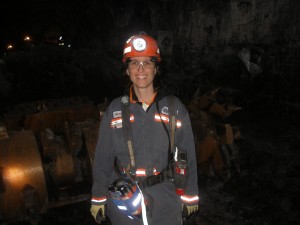Do Unions Make a Difference? Alison Morantz Examines the Data

Alison D. Morantz has an orange hardhat and a block of bituminous coal in her office—keepsakes from visits she made to a gold mine and a coal mine several years ago.
“I found it interesting,” she says, responding to a question about whether she was scared. The underground worlds were, she recalls, like underground cities—dark labyrinths of tunnels and off-shoots, extending for miles, hundreds of feet below the earth’s surface. Modern mines are extensively mechanized, “and sometimes it felt a bit eerie because there were so few people.”
And as with flying above ground, there was a safety talk before the start of each underground tour.
“You’re taught how to open—in total darkness—and then breathe through a metal box that generates its own oxygen supply after a mining disaster,” says Morantz, professor of law and John A. Wilson Distinguished Faculty Scholar. “It’s called a ‘self-contained self-rescuer,’ though I’m not sure I would have been able to rescue myself—I could barely open the box.”
Morantz is keenly aware of the dangers inherent in coal mining, having spent the best part of four years studying mine safety regulation. She is a nationally recognized occupational safety expert who, following the deadly explosion at the Upper Big Branch Mine in West Virginia in April 2010, was appointed by Secretary of Labor Hilda Solis to a National Institute of Occupational Safety and Health(NIOSH) panel that will provide an independent analysis of the internal review that the Mine Safety and Health Administration (MSHA) expects to complete in the next few months. In 2009, Morantz was awarded a half-million-dollar research contract from NIOSH to develop a statistically based algorithm to identify the nation’s most dangerous mines. Her empirical scholarship on mine safety, which relies on data from MSHA and the U.S. Department of Energy’s Energy Information Administration, focuses primarily on the last two decades.
The first part of that scholarship was released this year in Morantz’s (working) paper Coal Mine Safety: Do Unions Make a Difference? Her conclusion made headline news in parts of the country where mining is still a way of life: Underground, bituminous coal mines that are unionized report 17 to 33 percent fewer traumatic injuries and 33 to 72 percent fewer fatalities than those that are not. The safety record for coal mines in the United States has undoubtedly improved dramatically in the last century, from hundreds (often thousands) of deaths recorded each year between 1900 and 1945 to single- and double-digit numbers today. However, the 2010 Upper Big Branch Mine explosion, which took the lives of 29 miners, reminded the nation that, despite improvements, mining is still an extremely dangerous occupation. At a time when organized labor is on the decline, and many coal mines employ contract workers, the report’s conclusion is perhaps even more significant.
Looking at the Data
Morantz admits to being a bit paranoid and risk averse in general, but especially so when conducting empirical analysis that she knows might be ripped apart.
“Before conducting any analysis, I go through all of my data with a fine-tooth comb in an effort to identify and correct any mistakes. Later on, once I have what I think are credible findings, I try to be very upfront about my underlying assumptions and methodology and to post as much as possible online for others to scrutinize,” she says. “This is critical because with empirical work, there is always plenty of room for scholarly debate about whether the methodology is well suited to answering the research question and whether the correlations being reported tell us anything about cause and effect. This study is no exception.”
Given the robustness of her findings, however, Morantz suggests that “this study shifts the burden of proof onto the naysayers to muster empirical evidence in support of the view that unionization does not enhance coal mine safety.”
The study’s conclusion has been met with some surprise in the industry for another reason: It upended previously held conclusions—ones that had been supported by data too. But Morantz exposed flaws in assumptions made in earlier studies.
“Prior researchers usually looked at the rate of total reported injuries and concluded, correctly, that unionized mines report more accidents,” Morantz says. “But the inference that was often drawn—that unionized mines are at least as dangerous as non-unionized mines—is, I think I’ve shown, most likely false.”
Morantz believes that the disparity in total reported injuries is primarily a function of cultural and operational differences that make union mines more likely than nonunionized mines to track and report minor mishaps. So she narrowed her focus to fatal and traumatic injuries, which are much harder for mine owners to shield from regulatory scrutiny. When viewed in this light, a new and very different pattern was thrown into stark relief: Union mines report far fewer fatalities and traumatic injuries per hour than their non-unionized peers. In the coming year, Morantz plans to continue probing what she calls the complex interconnections between federal regulation, mines’ operational characteristics, and workplace safety—from both scholarly and practical perspectives.
“I hope that at the end of the day, all the hours of agonizing over deficiencies in the dataset and poring over regression results will pay off by helping MSHA identify the riskiest mines and protect miners whose lives are at stake before the next Upper Big Branch disaster occurs,” she says.
